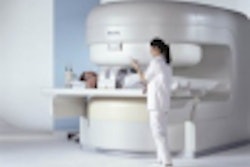CHICAGO - MRI added to the pre-treatment workup of patients with Crohn’s disease offers important information on the activity and extent of the illness as well as possible complications that may require surgery.
“The complete assessment of Crohn’s disease requires not only correct diagnosis, but also (the assessment) of disease activity, extent, complications, and follow-up,” said Dr. Francesca Maccioni from La Sapienza University in Rome in a presentation Tuesday at the 2002 RSNA meeting.
According to the Crohn’s and Colitis Foundation of America, 1 million people suffer from this chronic digestive disorder. Crohn's disease generally involves all layers of the intestinal wall, and may affect the lower part of the small intestine, the colon, and other parts of the digestive tract.
Currently, there is no gold standard modality for imaging this disorder; a combination of endoscopy, ultrasound, CT, nuclear medicine, and barium studies are used, Maccioni said.
For this study, 95 patients with Crohn’s disease underwent MRI in addition to biochemical, endoscopic, and histologic exams. MRI scans were performed on a 1.5-tesla scanner with phased array coils. T2-weighted images were acquired using HASTE, gadolinium-enhanced T1-weighted FLASH, and with and without fat suppression. A superparamagnetic contrast agent was administered one hour before imaging.
Two radiologists, blinded to the results, evaluated the images for bowel wall thickness, T1 gadolinium wall enhancement, T2 wall signal, and T2 signal for fibro-fatty proliferation. The images were then graded on a 0-3 scale to assess disease activity.
The final determination of disease activity reflected the results of endoscopy, biological activity, and the Crohn’s Disease Activity Index (CDAI). The final determination of morphology was based on one of the following: barium studies, sonography, CT, or surgery when performed.
In order to examine the extent of disease as well as the level of complication, the bowel was divided into seven segments: jejunum, ileum, right colon, transverse colon, descending colon, sigmoid colon, and rectum. In each segment, disease length, presence of strictures, fistulae, abscesses, phlegmons and other complications were assessed.
Maccioni reported that all of the MR criteria the radiologists used to evaluate the images strongly correlated with the clinical and biological signs of active Crohn’s disease. In addition, MRI was able to detect 90% of overall disease length, 75% of fistulae, and 92% of strictures. MRI did overestimate the presence of adhesions, she said.
For the purposes of treatment and follow-up, the results of the MR exams sent 12% of the patients to surgery because of complications. The MR results also proved helpful for post-treatment follow-up with newer pharmaceuticals, she said.
Maccioni was asked whether MR had any value in differentiating fistulae and strictures from disease activity, a distinction that can help gastroenterologists determine what types of drugs to administer. Maccioni pointed out that MRI was particularly sensitive to adhesions, which generally present as fistulae within a year.
By Shalmali Pal
AuntMinnie.com staff writer
December 3, 2002


.fFmgij6Hin.png?auto=compress%2Cformat&fit=crop&h=100&q=70&w=100)





.fFmgij6Hin.png?auto=compress%2Cformat&fit=crop&h=167&q=70&w=250)











